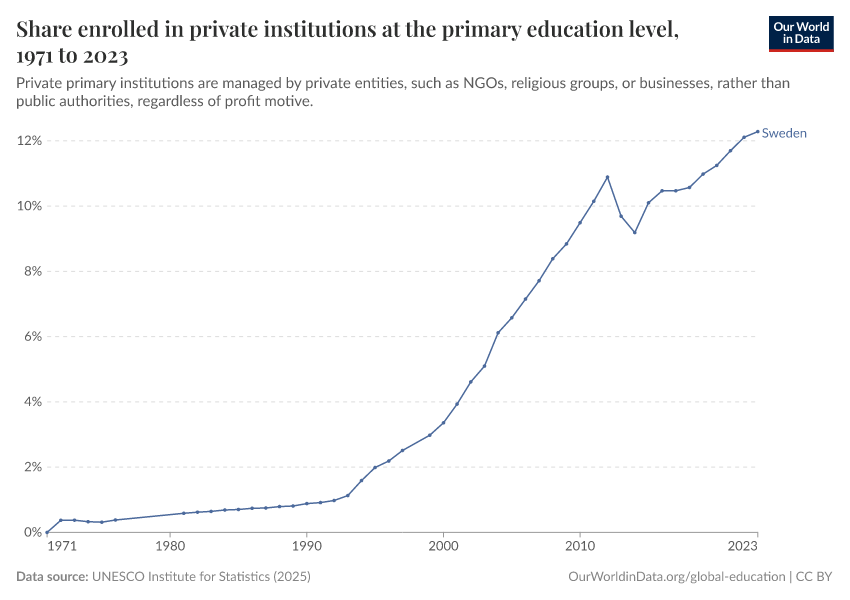Share enrolled in private institutions at the primary education level

What you should know about this indicator
- In many countries, education is provided not only by the government but also by private institutions — this indicator shows how much of total enrolment is taking place in privately run schools or educational programmes.
- It captures the share of students enrolled in private institutions at a given level of education as a percentage of all students enrolled at that level, including both public and private schools.
- The indicator is calculated by dividing the number of students in private institutions by the total number of students enrolled at the same education level, then multiplying by 100.
- A high percentage means that non-governmental providers — such as private individuals, companies, religious bodies, or community organizations — play a significant role in delivering education at that level.
- The data comes from school censuses and other administrative records that report enrolment numbers by type of institution and education level.
- This indicator is often disaggregated by level of education and by sex, allowing for analysis of how the role of private education differs across schooling stages and between boys and girls.
- There are some important limitations. In some countries, the distinction between public and private institutions is blurred — especially where private schools receive government subsidies or public funds are used to support student enrolment through scholarships.
- Additionally, some private schools may operate without formal registration or may not follow national curricula, which can lead to underreporting and incomplete data in official statistics.
- Despite these challenges, this indicator helps assess the scale and role of the private education sector within a national education system and informs discussions about education financing, accessibility, and regulation.
What you should know about this indicator
- In many countries, education is provided not only by the government but also by private institutions — this indicator shows how much of total enrolment is taking place in privately run schools or educational programmes.
- It captures the share of students enrolled in private institutions at a given level of education as a percentage of all students enrolled at that level, including both public and private schools.
- The indicator is calculated by dividing the number of students in private institutions by the total number of students enrolled at the same education level, then multiplying by 100.
- A high percentage means that non-governmental providers — such as private individuals, companies, religious bodies, or community organizations — play a significant role in delivering education at that level.
- The data comes from school censuses and other administrative records that report enrolment numbers by type of institution and education level.
- This indicator is often disaggregated by level of education and by sex, allowing for analysis of how the role of private education differs across schooling stages and between boys and girls.
- There are some important limitations. In some countries, the distinction between public and private institutions is blurred — especially where private schools receive government subsidies or public funds are used to support student enrolment through scholarships.
- Additionally, some private schools may operate without formal registration or may not follow national curricula, which can lead to underreporting and incomplete data in official statistics.
- Despite these challenges, this indicator helps assess the scale and role of the private education sector within a national education system and informs discussions about education financing, accessibility, and regulation.
Sources and processing
This data is based on the following sources
How we process data at Our World in Data
All data and visualizations on Our World in Data rely on data sourced from one or several original data providers. Preparing this original data involves several processing steps. Depending on the data, this can include standardizing country names and world region definitions, converting units, calculating derived indicators such as per capita measures, as well as adding or adapting metadata such as the name or the description given to an indicator.
At the link below you can find a detailed description of the structure of our data pipeline, including links to all the code used to prepare data across Our World in Data.
Reuse this work
- All data produced by third-party providers and made available by Our World in Data are subject to the license terms from the original providers. Our work would not be possible without the data providers we rely on, so we ask you to always cite them appropriately (see below). This is crucial to allow data providers to continue doing their work, enhancing, maintaining and updating valuable data.
- All data, visualizations, and code produced by Our World in Data are completely open access under the Creative Commons BY license. You have the permission to use, distribute, and reproduce these in any medium, provided the source and authors are credited.
Citations
How to cite this page
To cite this page overall, including any descriptions, FAQs or explanations of the data authored by Our World in Data, please use the following citation:
“Data Page: Share enrolled in private institutions at the primary education level”, part of the following publication: Hannah Ritchie, Veronika Samborska, Natasha Ahuja, Esteban Ortiz-Ospina, and Max Roser (2023) - “Global Education”. Data adapted from UNESCO Institute for Statistics. Retrieved from https://archive.ourworldindata.org/20250909-093708/grapher/precentage-enrolled-in-private-institutions-at-the-primary-education-level.html [online resource] (archived on September 9, 2025).How to cite this data
In-line citationIf you have limited space (e.g. in data visualizations), you can use this abbreviated in-line citation:
UNESCO Institute for Statistics (2025) – with minor processing by Our World in DataFull citation
UNESCO Institute for Statistics (2025) – with minor processing by Our World in Data. “Share enrolled in private institutions at the primary education level” [dataset]. UNESCO Institute for Statistics, “UNESCO Institute for Statistics (UIS) - Education” [original data]. Retrieved December 27, 2025 from https://archive.ourworldindata.org/20250909-093708/grapher/precentage-enrolled-in-private-institutions-at-the-primary-education-level.html (archived on September 9, 2025).